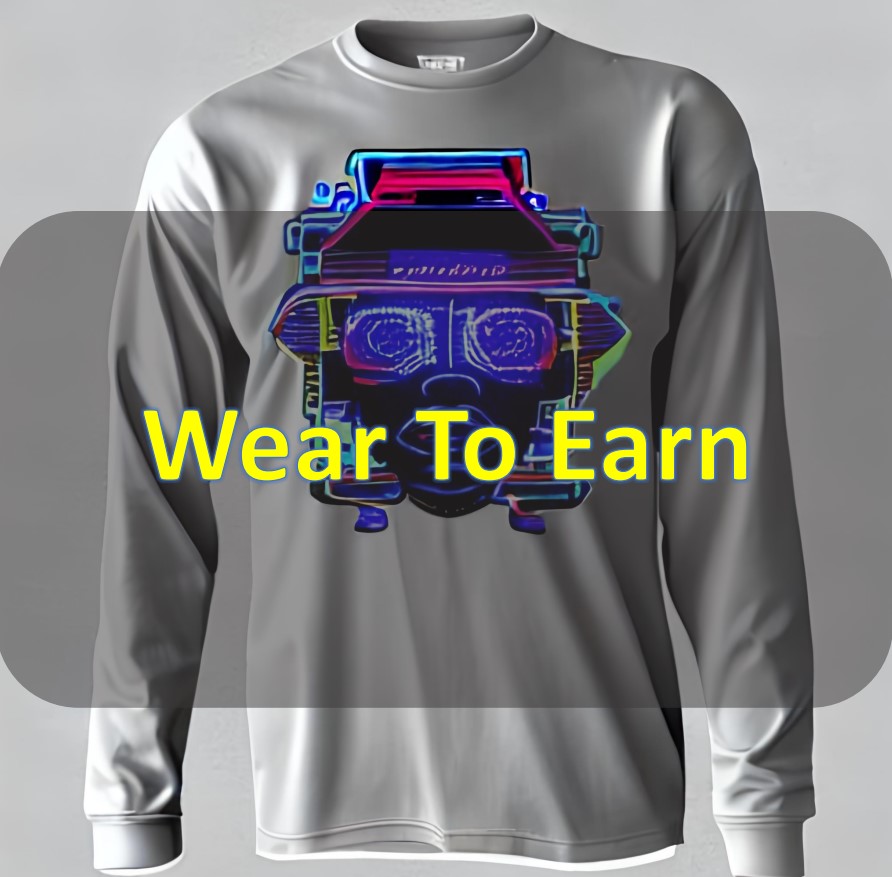“Wear to earn” refers to a concept in the blockchain and cryptocurrency space where individuals can earn digital tokens or rewards by wearing or using certain wearable devices or applications. This concept leverages the growing popularity of wearable technology and combines it with blockchain technology to incentivize users for their activities or behaviors.
The basic idea behind wear to earn is that users wear a specific device or use an application that tracks their activities, such as physical exercise, health data, or other actions. This data is then recorded on a blockchain, which ensures transparency, immutability, and security. In return for their participation and data sharing, users are rewarded with digital tokens or other forms of cryptocurrency.
These rewards can be used in various ways, depending on the specific platform or ecosystem. For example, users may be able to redeem their earned tokens for discounts on products or services, access exclusive content, participate in auctions, or trade their tokens on cryptocurrency exchanges.
Wear to earn platforms aim to incentivize healthy behaviors, promote user engagement, and create new opportunities for monetizing personal data. They often target industries such as fitness, healthcare, and wellness, where wearable devices are already popular. However, it’s important to note that wear to earn is a rapidly evolving concept, and there may be different variations or implementations depending on the specific platform or project.
Digital clothing
Digital clothing, also known as virtual clothing or digital fashion, refers to clothing items that exist only in the digital realm and can be worn or displayed on virtual avatars or in virtual environments. Unlike traditional physical clothing, digital clothing does not have a tangible presence and cannot be physically worn or touched.
Digital clothing has gained popularity with the rise of virtual reality (VR) and augmented reality (AR) technologies, as well as the growth of virtual worlds and social platforms. It allows users to customize their avatars or virtual representations by dressing them in various digital garments, accessories, and styles.
The creation and distribution of digital clothing often involve 3D modeling and rendering techniques. Designers create the virtual garments using specialized software and then map them onto the 3D model of the avatar. Digital clothing can range from simple designs to complex and elaborate pieces that replicate real-world fashion.
Digital clothing serves different purposes in various contexts. In gaming, it allows players to personalize their characters and enhance the overall visual experience. In virtual worlds and social platforms, digital clothing enables self-expression and fashion experimentation without the constraints of physical garments. It also opens up opportunities for fashion collaborations, virtual fashion shows, and even digital fashion marketplaces where users can buy and sell virtual garments.
While digital clothing does not have a physical presence, it has its own unique market and economy. Some users are willing to pay real money to acquire exclusive or limited-edition digital garments, making it a niche but growing sector within the broader fashion and gaming industries.
Wear to earn projects and the pioneers of this project
There are several wear-to-earn projects in the blockchain and cryptocurrency space, each with its own unique approach and features. Here are a few notable examples and pioneers in this field:
1. Sweatcoin: Sweatcoin is a popular wear-to-earn app that rewards users with its native cryptocurrency, Sweatcoin (SWC), for outdoor steps they take. The app tracks users’ steps using their smartphone’s GPS and accelerometer, converting them into Sweatcoin tokens. Users can then redeem these tokens for various goods, services, or discounts offered by partnering brands.
2. Lympo: Lympo is a blockchain-based fitness app that rewards users with its native token, called LYM, for completing various fitness challenges and activities. The app tracks users’ workouts and allows them to earn LYM tokens, which can be used to purchase fitness-related products, services, or experiences.
3. Bitwalking: Bitwalking was an early pioneer in the wear-to-earn space. It aimed to convert users’ steps into a digital currency called Bitwalking Dollars (BW$). Users would wear a specialized wearable device, such as a smart wristband, which tracked their steps and converted them into BW$. The project aimed to provide a way for individuals in underprivileged regions to earn income through their physical activity.
4. EarthTones: EarthTones is a project that explores the concept of wearable mining. It aims to reward users with cryptocurrency for generating energy using wearable devices, such as smartwatches. The energy generated through the devices is converted into EarthTokens, which can be traded or redeemed for various benefits.
5. GEMS: GEMS is a blockchain-based social messaging app that incorporates a wear-to-earn feature. Users can earn GEMS tokens by engaging in positive behaviors, such as responding to messages, sharing quality content, or participating in community moderation. The tokens can be used for in-app purchases or exchanged for other cryptocurrencies.
6. Pi Network: Pi Network is a decentralized cryptocurrency project that aims to create a user-friendly digital currency accessible to everyone. Users can mine Pi coins through a mobile app by contributing their time and attention to the network. While it doesn’t strictly involve wearables, Pi Network’s approach focuses on user engagement and rewards based on their daily interactions with the app.
7. Opu Labs: Opu Labs is a blockchain-powered skincare platform that rewards users for sharing their skincare data. Users can earn Opu Coins by completing skincare-related tasks, participating in surveys, or uploading photos of their skin condition. The earned tokens can be used to access skincare products or services within the platform.
8. Verasity: Verasity is a video-sharing platform that utilizes blockchain technology and offers a wear-to-earn feature. Users can earn VRA tokens by watching and engaging with videos on the platform. The tokens can be used for various purposes, such as accessing premium content, tipping creators, or participating in the platform’s ecosystem.
9. FitVitalik: FitVitalik is a wear-to-earn project that is inspired by the Ethereum co-founder Vitalik Buterin. It rewards users for completing fitness challenges and activities. Users can earn FitVitalik tokens, which can be used for various purposes, such as redeeming rewards, accessing exclusive content, or participating in the project’s ecosystem.
10. XYO Network: XYO Network is a decentralized location-based platform that rewards users for providing location data through their devices. Users can earn XYO tokens by contributing their location information to the network, which is used for various applications, such as supply chain tracking or location-based marketing.
11. MyBit Go: MyBit Go is a blockchain-based platform that enables users to invest in Internet of Things (IoT) devices and earn passive income. Users can purchase IoT devices, such as solar panels or wind turbines, and earn tokens based on the energy generated by these devices. The tokens represent a share of the device’s revenue, providing users with a form of “wearable mining” through their ownership of IoT devices.
12. BitGym: BitGym is a fitness app that rewards users for exercising on cardio machines, such as treadmills or stationary bikes. Users can earn BitGym tokens by completing workouts, which can be used to unlock premium content or access additional features within the app.
13. Plair: Plair is a blockchain-based gaming platform that incorporates wear-to-earn features. Users can earn Plair tokens by participating in gaming activities, such as playing games, achieving milestones, or engaging in esports tournaments. The tokens can be used for in-game purchases, accessing exclusive content, or trading on cryptocurrency exchanges.
14. Upgraded: Upgraded is a wear-to-earn project that focuses on sustainable fashion. Users can earn Upgraded tokens by wearing sustainable clothing brands and sharing their fashion choices on social media. The tokens can be used to redeem discounts, access exclusive events, or support charitable causes related to sustainability.
15. Liven: Liven is a blockchain-based platform that rewards users for dining out at participating restaurants. Users can earn Liven tokens by making purchases at partner restaurants, which can be used for future dining experiences or converted to other cryptocurrencies.
16. StyleDotMe: StyleDotMe is a virtual try-on platform that allows users to try on and purchase virtual jewelry and accessories. Users can earn rewards by participating in fashion challenges, providing styling advice, or sharing their virtual looks on social media. The rewards can be used to unlock additional virtual items or redeem discounts on real-world jewelry.
17. Bitizens: Bitizens is a blockchain-based virtual world where users can earn rewards by participating in various activities, such as socializing, exploring, or creating virtual content. Users can earn Bitizens tokens, which can be used to customize their avatars, purchase virtual land, or trade with other users.
These projects and pioneers demonstrate the diverse applications of wear-to-earn concepts, ranging from gaming and sustainability to dining and virtual fashion. Each project offers unique opportunities for users to earn rewards or tokens by leveraging wearable technology, engaging in specific activities, or contributing to the respective platforms.
The future of digital clothing
The future of digital clothing holds significant potential for transforming the fashion industry and personal expression. Here are some key aspects to consider:
1. Virtual Fashion: Digital clothing allows individuals to express themselves creatively through virtual avatars, social media, and virtual worlds. People can personalize their digital identities by mixing and matching virtual garments, accessories, and styles without the limitations of physical fabric or manufacturing processes. Virtual fashion opens up new avenues for self-expression and exploration of diverse styles and aesthetics.
2. Sustainability and Reduced Waste: Digital clothing presents an environmentally friendly alternative to traditional fashion. It eliminates the need for physical production, reducing the consumption of resources and minimizing waste. Instead of discarding clothing after limited use, users can continually update their digital wardrobes without impacting the environment. Digital clothing promotes the concept of “less is more” by encouraging reuse and reducing textile waste.
3. Collaborations and Design Opportunities: Digital fashion allows designers to explore innovative and boundary-pushing designs that may not be feasible in the physical realm. It enables collaborations between fashion designers, 3D artists, and technologists to create unique and immersive experiences. Collaborative digital platforms can bring together various creative disciplines, fostering new forms of expression and pushing the boundaries of fashion design.
4. Augmented Reality Integration: Augmented reality (AR) technology can enhance the experience of digital clothing by overlaying virtual garments onto the real world. Users can virtually try on clothes before making a purchase, see how different styles suit them, and even customize the appearance of their physical surroundings. AR integration offers an interactive and immersive way to engage with digital fashion and bridge the gap between virtual and physical realities.
5. Digital Fashion Marketplaces: As the demand for digital clothing grows, dedicated marketplaces and platforms are likely to emerge. These platforms can facilitate the buying, selling, and trading of digital garments, accessories, and designs. Digital fashion marketplaces can also provide opportunities for fashion designers and creators to monetize their creations, while users can discover and access a wide range of digital fashion options.
6. Blockchain and Authenticity: Blockchain technology can play a crucial role in establishing the authenticity and ownership of digital clothing. Blockchain-based solutions can verify the origin and uniqueness of digital garments, enabling users to collect and trade limited-edition or rare items securely. Additionally, blockchain can enable transparent and traceable supply chains for digital fashion, ensuring ethical practices and supporting sustainable initiatives.
While digital clothing is still in its early stages, it has the potential to revolutionize the fashion industry, redefine personal style, and contribute to sustainability efforts. As technology continues to advance, we can expect to see more seamless integration of digital clothing into our everyday lives, creating new possibilities for self-expression, creativity, and fashion experiences.







